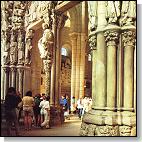 A rest stop on the Celts’ journey to Ireland around 900BC, Celtiberian influences endure. Ancient castros (fortress-villages), inscriptions, dolmenes (funerary chambers), and gaitas (bagpipes) testify to Galicias’s Celtiberian past, as does lingering lore about witches, fountain fairies and buried treasure.
A rest stop on the Celts’ journey to Ireland around 900BC, Celtiberian influences endure. Ancient castros (fortress-villages), inscriptions, dolmenes (funerary chambers), and gaitas (bagpipes) testify to Galicias’s Celtiberian past, as does lingering lore about witches, fountain fairies and buried treasure.
|
|
Ever since the remains of the Apostle St. James were discovered there in 813 AD, Santiago has drawn myriads of pilgrims, many walking for years to worship at its cathedral. The esteemed relics lifted Santiago into the ranks of one of Christianity’s three holy cities, alongside Rome and Jerusalem. Its cathedral marks the end of an 800-year-old 900km pilgrimage believed to halve one’s time in purgatory. 
Galiza o Galicia es la región más al noroeste de España. Pais verde y mágico, repleto de pequeñas y redondeadas montañas, valles, rios, vacas y fuentes. Tierra marinera y labradora, sus recortadas costas hacen que tenga más km de costa que todo el resto de España junto, y la flota pesquera más grande de Europa. Con una lengua y una cultura propia y milenaria. El legado preromano de los celtas y las tribus indigenas permanece vivo, y aunque escondido, se muestra amenudo en forma de ruinas, monumentos, nombres de lugar, costumebres, ritos disfrazados de cristianos y leyendas. Está aquí muy asentada la religión católica. En Santiago, la pequeña capital de Galicia y elegida como capital europea de la cultura del año 2000, donde la lluvia se hace poesia, está el sepulcro del apóstol Santiago. Fue este apóstol quien trajo a galicia la religion cristiana, pues recivió de su maestro Jesucristo la orden de predicar su palabra hasta los confines del mundo, y es aquí, en un cabo llamado Fisterra para ser mas exactos, donde el mundo clasico situo el fin de la tierra. Es Santiago, despues de Roma y Jerusalem, el principal centro de peregrinación católico desde tiempos de la edad media, mas de siete millones de personas de todo el mundo pasaron por esta localidad de apenas cien mil habitantes en 1999, año Santo "Xacobeo". Se conoce así al año en que se abre la puerta santa de la catedral, todo el que por ella pase ganará el perdón eterno para el alma de un ser querido. Please feel free to contact me with any questions! rbeja@hotmail.com or ICQ #10172277 Home - Meet Your Guides - Asturias - Galicia - Catalunya - The Culinary Experience The Club - The Journey - Maps - Traveler's Quotes - I Want To Join
|


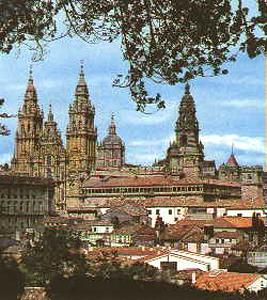
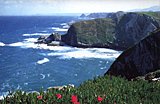


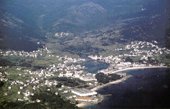

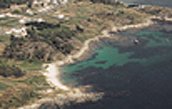

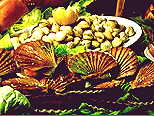 Regional cuisine features "caldo gallego" (a vegetable broth), "pulpo a la gallega" (marinated octopus), "vietras" (scallops, the pilgrim’s trophy), and the "empanada" (turnover/pastry stuffed with tomato and tuna, bakala, chicken and meat among other fillings). "Tetilla" is a creamy, tangy cheese, delicious especially when eaten with the area’s tart and slightly cloudy Ribeiro wine.
Regional cuisine features "caldo gallego" (a vegetable broth), "pulpo a la gallega" (marinated octopus), "vietras" (scallops, the pilgrim’s trophy), and the "empanada" (turnover/pastry stuffed with tomato and tuna, bakala, chicken and meat among other fillings). "Tetilla" is a creamy, tangy cheese, delicious especially when eaten with the area’s tart and slightly cloudy Ribeiro wine.
